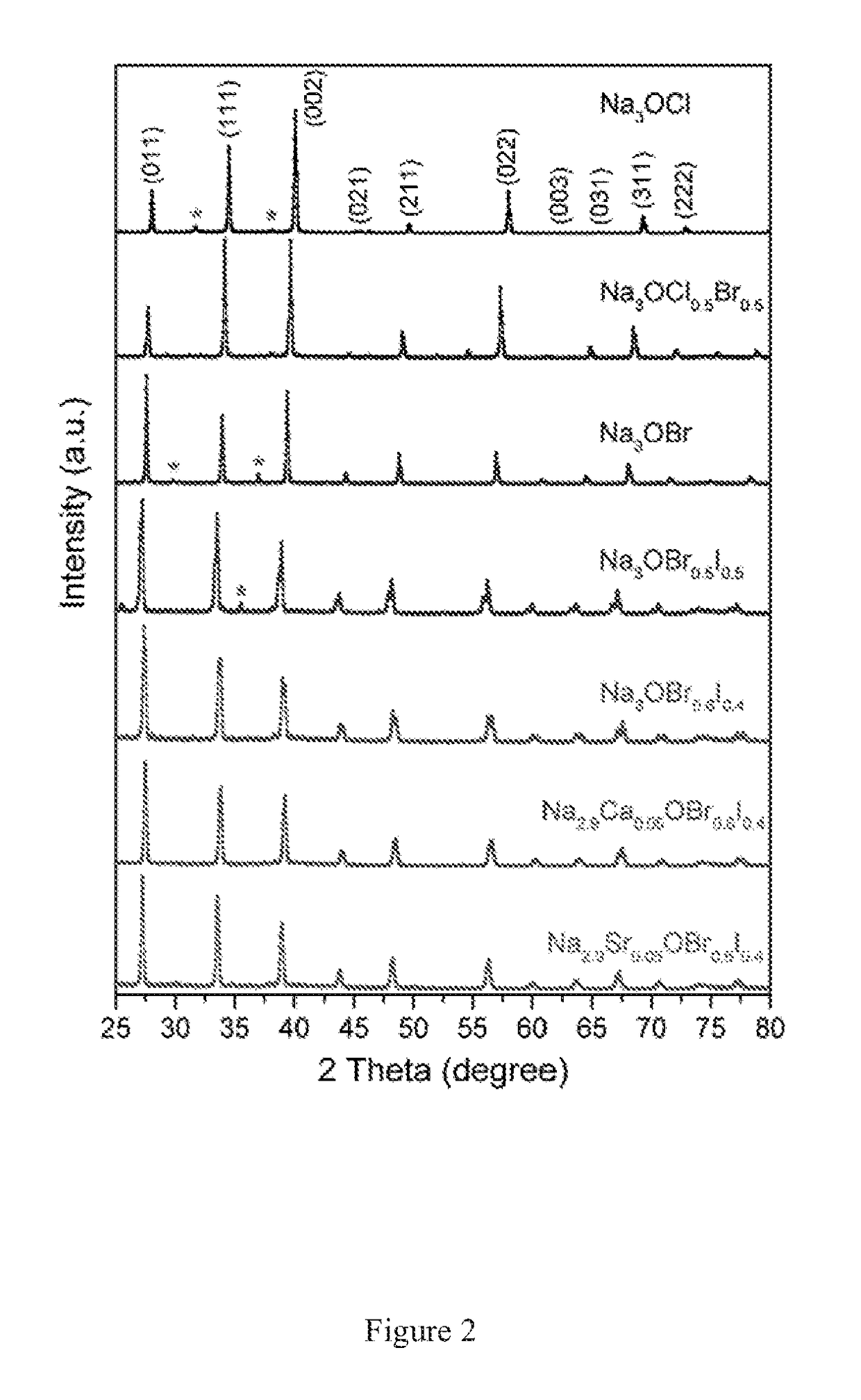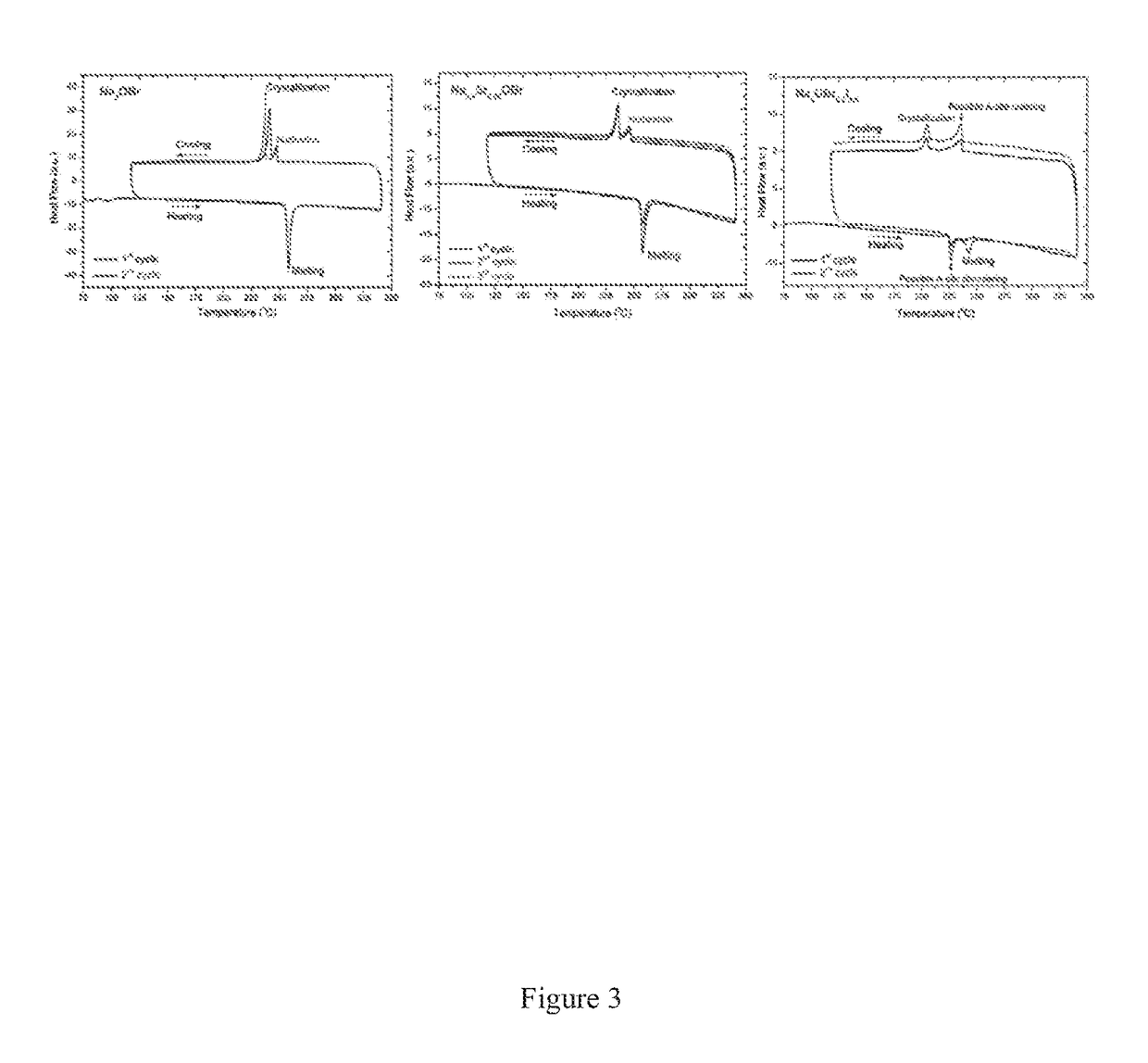Sodium Anti-perovskite solid electrolyte compositions
a technology of anti-perovskite and solid electrolyte, which is applied in the direction of sodium/potassium compounds, crystal growth processes, magnesium compounds, etc., can solve the problems of high cost and inflammability, bad machinability, etc., and achieves enhanced sodium transport rates, favorable structure flexibility, and ionic conductivity. high
- Summary
- Abstract
- Description
- Claims
- Application Information
AI Technical Summary
Benefits of technology
Problems solved by technology
Method used
Image
Examples
example a
[0035]Preparation of Na3OCl: 0.400 g NaOH and 0.585 g NaCl are weighted and ground together in N2 atmosphere for several minutes. The resulting fine powder is paved on 0.253 g Na metal and the mixture is placed in an alumina crucible and then sealed in a quartz tube. The sample is firstly heated to 150° C. (past the melting point Tm=97.8° C. of Na metal) under vacuum at a heating rate of 1.5° C. / min, then to 350° C. at a heating rate of 10° C. / min. During heating process 1 mol reactant will release 0.5 mol H2, so that caution and proper disposal must be taken when conduct the experiment and the total amount of the raw materials should be well schemed. After holding at the highest reacting temperature for 3 hours, the samples are cooled to room temperature naturally. Phase-pure powders of Na3OCl can be obtained by repeating the grinding and heating processes for 3 times. The overall synthesis approach of a batch of samples costs about 24 hours.
[0036]Powder X-ray diffraction data were...
example b
[0039]Preparation of Na3OBr0.5I0.5: 0.400 g NaOH, 0.515 g NaBr, and 0.645 g NaI are weighted and ground together in N2 atmosphere for several minutes. The resulting fine powder is paved on 0.253 g Na metal and the mixture is placed in an alumina crucible and then sealed in a quartz tube. The sample is firstly heated to 150° C. (past the melting point Tm=97.8° C. of Na metal) under vacuum at a heating rate of 1.5° C. / min, then to 350° C. at a heating rate of 10° C. / min. After holding at the highest reacting temperature for 3 hours, the samples are cooled to room temperature naturally. Phase-pure powders of Na3OBr0.5I0.5 can be obtained by repeating the grinding and heating processes for 3 times. The overall synthesis approach of a batch of samples costs about 24 hours.
[0040]Powder X-ray diffraction data were collected at room temperature (25° C.). Before measurements, the samples were enclosed in a laboratory film (PARAFILM “M”) under N2 atmosphere to avoid moisture absorption. An X-...
example c
[0041]Preparation of Na2.9Sr0.05OBr0.5I0.5: 0.360 g NaOH, 0.515 g NaBr, 0.645 g NaI and 0.052 g SrO are weighted and ground together in N2 atmosphere for several minutes. The resulting fine powder is paved on 0.253 g Na metal and the mixture is placed in an alumina crucible and then sealed in a quartz tube. The sample is firstly heated to 150° C. (past the melting point Tm=97.8° C. of Na metal) under vacuum at a heating rate of 1.5° C. / min, then to 350° C. at a heating rate of 10° C. / min. After holding at the highest reacting temperature for 3 hours, the samples are cooled to room temperature naturally. Phase-pure powders of Na2.9Sr0.05OBr0.5I0.5 can be obtained by repeating the grinding and heating processes for 3 times. The overall synthesis approach of a batch of samples costs about 24 hours.
[0042]Powder X-ray diffraction data were collected at room temperature (25° C.). Before measurements, the samples were enclosed in a laboratory film (PARAFILM “M”) under N2 atmosphere to avoi...
PUM
| Property | Measurement | Unit |
|---|---|---|
| Percent by atom | aaaaa | aaaaa |
| Percent by atom | aaaaa | aaaaa |
| Percent by atom | aaaaa | aaaaa |
Abstract
Description
Claims
Application Information
 Login to View More
Login to View More - R&D
- Intellectual Property
- Life Sciences
- Materials
- Tech Scout
- Unparalleled Data Quality
- Higher Quality Content
- 60% Fewer Hallucinations
Browse by: Latest US Patents, China's latest patents, Technical Efficacy Thesaurus, Application Domain, Technology Topic, Popular Technical Reports.
© 2025 PatSnap. All rights reserved.Legal|Privacy policy|Modern Slavery Act Transparency Statement|Sitemap|About US| Contact US: help@patsnap.com



